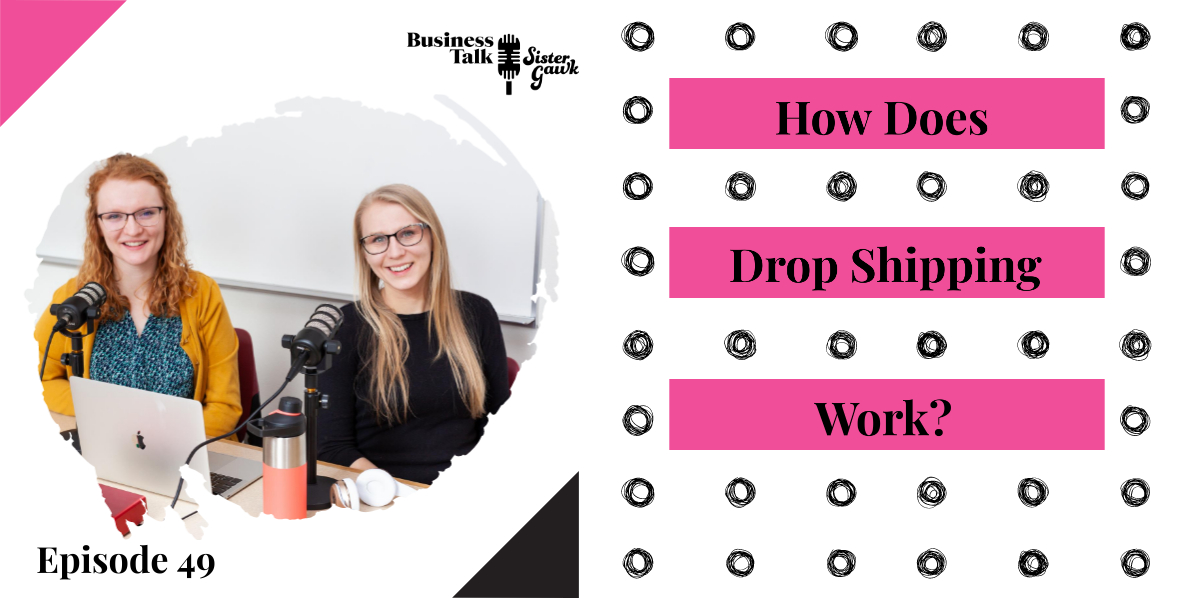In this episode, Bekkah explains all things drop shipping. For a topic that seems pretty hard to follow sometimes, Bekkah breaks down the different ways people choose to drop ship and the reasons behind the different approaches that are out there.
Ruthie: So, Bekkah, to start with, tell us a little bit about what kind of businesses would benefit from utilizing drop shipping.
What is Drop Shipping Exactly?
Bekkah: Yeah so let’s get to really what drop shipping is entirely. Dropshipping is about offering a physical product that can be bought through you and shipped directly to your customer from the supplier without you having to ever touch the product physically. Businesses that could benefit, if they’re looking to potentially diversify – if you’re already working with products and you’re looking to expand the inventory that maybe you offer on your website.
That’s a great place to look and see if that could be a good fit. Other places, if you’re already selling on a third-party website service such as like Amazon or Etsy or whatever dropshipping additional products may potentially work for you, but Etsy is kind of hit and miss depending on what it is. If you deep dive into print on demand which we’re gonna do an episode about next week!
Ruthie: *Dun duhh!*
Bekkah: So definitely stick around for that – that could potentially be a good fit. I guess that’s where I would start with that. Dropshipping is not for everybody and it can get pretty complicated if you don’t know anything about it. We’re going to get into a couple of different aspects of that.
Ruthie: Explain to us kind of how dropshipping works. I know you kind of said that it’s for people who have products, but how would that actually work then? Would they not have to the house –
Bekkah: Inventory? Yeah so, when we’re talking about dropshipping there are two ways that people go about it and it really depends on their circumstances. The first way is that they know exactly what they want to sell to add to their inventory. They’re finding a supplier that sells that product. They look and a lot of suppliers and sometimes manufacturers will do this, too. It really depends on what your specific product is.
Let’s just say you want to go with a pocket watch or a watch in general, you want to sell that. You would go out and find which suppliers you can purchase that from just like any retail business would if you owned like a little mom-and-pop shop – where can you buy those to sell to your customers? As you’re looking for those things a lot of times a supplier, if they’re not directly the manufacturer, the supplier is actually working with manufacturers to get a huge inventory.
They’ll have big catalogs or excel spreadsheets with VIN numbers or whatever. I don’t remember the exact name – UPC codes potentially? Of products that they offer and you can say, “Okay, this is what I want to buy,” and you can match it up with your inventory system so that’s one way you can go about it if you know the specific product you already want to get. The second way you can go about it is maybe by deciding what type of products you want to sell by looking at what the suppliers already have. So finding suppliers and looking through their inventory to see “Hey, maybe I want to sell this.”
Ruthie: So first is need-based – what you need to sell and the second is more convenience-based. If you like working with a specific vendor then you would try to sell their products more?
Bekkah: Yeah, and what’s really interesting, I’ve been watching this a little bit is that there is way more of these independent supplier companies that are really hitting the ground right now trying to say to retail companies, “Oh, you should buy your unique gifts from us. We work with all of these handmade people.” They’re basically trying to be the go-between for maybe people that used to sell on Etsy to consumers but they’re like, “I’d rather do bulk orders.” I’ve been seeing a lot of movement in that especially for targeted ads. A lot of new companies are popping up trying to get out there. That’s been really interesting to see that aspect.
Ruthie: Is this something that you would use in partnership with a brick and mortar store or would you only use dropshipping if you have an online presence?
Why Did Dropshipping Start?
Bekkah: Yeah so dropshipping originally started because people wanted to not have all that inventory. Most of the people are not retail. They’re actually people that want to sit at home and function an entire business from their home and do everything on the internet. Now with that being said there originally were quite a few people that were very successful with dropshipping and it’s because they also had a good knowledge of sales and marketing. Then they started producing all of these tutorial videos that you had to pay for.
It was the ugly start to a get-rich-quick scheme that kind of came out after Amazon. A ton of people that are already into the internet wanted to try this out and the thing about any kind of business is that it’s going to go really poorly if you’re doing it as a get-rich-quick scheme because you have to actually put in the time and effort to make it successful. Let’s talk a little bit about how do you decide what you’re going to sell or where you’re going to sell.
Where Do People Choose to Do Dropshipping?
I think that is where it’s really important to understand the products and all of that, right? There’s a lot of different places that people dropship through. Amazon, Etsy, Shopify, their own website like a WordPress or a Wix and then Walmart actually just rolled out their own dropshipping option as well. I’ve actually bought some stuff on Walmart and then it’s gotten shipped to me and I’m like, “Okay, I need to manage a return” and they’re like, “Oh, well, you have to have to talk to this person, because they really sold you the product!”
Ruthie: Which is a horrible experience! That’s happened to me before and it’s not the return process after the fact is not a good time.
Bekkah: Yeah so they’ve been Beta testing because they want to compete more with Amazon. Dropshipping got really popular with Amazon and that’s also where a lot of people got burned because there are a lot of things that you can do to other sellers on Amazon to make their products not sell.
Ruthie: Like what?
Bekkah: Like bad reviews or reporting their products as fraudulent, a ton of different things that people are sneaky and do to each other when they’re trying to compete for the same thing. There’s that. There’s just a lot of other rules that Amazon also has so if you’re not up to date on the rules that Amazon’s setting out for sellers you can really get yourself nailed on some different aspects.
It’s important to keep up with whatever platform that you choose. The time investment is also a big part of choosing the platform. Now when I was talking about people who build their own website, that can be a good long-term strategy to not be dependent on the whims and changes of Amazon or Walmart, but the big thing with that is that you also have to like be pretty tech-savvy to know how to actually get exposure for your website.
Ruthie: How would you for payment processing – Amazon obviously you pay through Amazon, but on your own WordPress site how do you manage payment processing?
Bekkah: Well, a lot of that has to do with e-commerce in general and Shopify also is another one that has a pretty one-stop-shop payment processing. Everything’s pretty easily set up. It’s also a higher cost overall in terms of operations, so WordPress has a lot of different plug-in integrations for e-commerce and then those usually connect up with something like a Paypal or Stripe or different I think even Venmo now.
I am realizing too that I completely missed a new way that also people are selling a lot which we kind of talked about in the past and touched on as we watch Shopify partner with Facebook is that can sell directly from there. I haven’t looked into a lot of people that have done dropshipping on Facebook but it’s definitely something that’s out there. When we’re talking about choosing where you’re going to sell the flexibility and control is a big piece of that.
The flexibility to get stuff out there is really easy with Amazon and Shopify but there’s a big difference in control of those platforms. Because Shopify everything you do is yours and you also have to do the work to market yourself. Whereas with Amazon it’s a little bit easier to market yourself because there’s already that trust factor built with the consumer knowing if they buy from Amazon if they have a return issue whatever they can trust that.
But there’s limited control with amazon versus an independent website that you have so um if a customer has a negative experience and they try to contact you, Amazon has really limited your ability to email the customer or talk with them and resolve whatever product issue they’re having.
Ruthie: Did you say yearability?
Bekkah: “User ability”.
Ruthie: Oh, I was like, “What does that mean?” Oh, okay. You had mentioned one thing that I wanted to ask about. For Shopify, that’s not like the same kind of thing that Amazon has where it’s its own platform. Is Shopify a plugin that you put in a website?
Bekkah: No, Shopify is its own website. It’s like Wix, but probably way more advanced than Wix. So that’s a really big place that people are using right now because if it’s usability for somebody who doesn’t know a ton about websites. You can get a lot of products up really quickly.
Ruthie: So it’s basically like a website platform that you can build on?
Bekkah: Yeah specific to their niche is e-commerce.
Ruthie: Gotcha.
The Benefit of Working with Manufacturers That Do a Lot of Drop Shipping
Bekkah: Yeah and one thing I did forget to mention about suppliers who do work with dropshipping pretty regularly, they a lot of times will supply you the product images and especially if you’re working with a place like Amazon or you’re trying to make your website look really professional, you want those backgroundless images of the products. They’ll supply you all those things you just need to like upload them and make sure all the tagging is done correctly, but the big difference too in deciding where you’re going to sell is the price per transaction or even your overall operating costs.
As you start doing more to get exposure or whatever you might want to invest in advertising or Amazon and Etsy or even Walmart they’ll charge a transaction fee and I believe Etsy charges 20 cents a listing just to have it even out there. Understanding where your target market is is really important before choosing the platform you’re going to use because if you don’t know what kind of product you’re going to sell you don’t even want to pick a platform. So research is super important.
We’re going to talk a little bit about that when you’re talking about how to research dropshipping, there are a ton of tools that are out there but you should always, always do a deep dive in all of these different areas if you find somebody talking about a specific thing. You’re really going to want to Google it or watch videos on it.
Why People Think Dropshipping is a Scam
There’s a lot of free content already out there but that’s the reason that a lot of people have a bad taste in their mouth from dropshipping is that they’ll maybe buy an educational program from somebody and then be like, “Okay, I’m gonna try this out,” and maybe they just don’t stick with it or whatever and they’re like, “Oh, nobody makes money at this.” I’m not gonna say that everybody makes money because that’s not true, but the people who are relatively more successful than others are people that have a good handle on their product, their target market, they understand how to keyword, and know how to work in technology pretty well.
Ruthie: So what I’m hearing is I should decide to just buy a whole bunch of different courses and then I should just –
Bekkah: That is the opposite of what you’re hearing.
Ruthie: I’ll learn about SEO. I’ll learn about Shopify and I should just keep buying them until I find one that works.
Bekkah: No, not at all. Not at all. There’s a ton of free information out there and that’s why I think it’s really good to get a good handle on things that um are encompassing all of these different areas first. I mean you don’t have to be a search engine optimization expert, but knowing what goes into it is going to help you understand what decision is going to be best for you. You should always research the volume and numbers of a product that you’re looking at we have a free resource tool on our tools and tips page of our website that is call Jungle Scout Sales Volume Estimator.
I really like that because it’s completely free you can put like the seller number, rank or whatever of the product and see kind of what the relative monthly movement is. We’ve actually found in the people that we’ve talked to that do a lot of sales with Amazon they’ve confirmed for us that that tool is pretty accurate. There are other tools out there but I would be very wary of choosing one unless you’ve heard from people that have used it that they think that the numbers really do ring true to what’s actually going on within the market.
Ruthie: Yeah and just a plug for our website it’s businesstalksistergawk.com so and then you can find the tools and tips page there to access Jungle Scout, or you could just Google it, but also you could go to our website! *both laugh*
Bekkah: Yeah there’s also a paid version of Jungle Scout, but that’s for the Chrome extension and you don’t really need that. Unless you’re doing a ton of it and it’s time-saving and then it’s like, “Okay, maybe this is actually something.” For what you’re looking at just in creeping on other people’s products you’re probably not gonna need it right away.
Looking at how dependent you want to be in other third parties is good but pay attention to the costs and when to diversify, because maybe you start with Amazon but one wrong move with Amazon or one misconnection or a couple bad reviews and it could really tank a lot of stuff. Or if a lot of other people are starting to sell the exact same product as you.
Who Are Third Parties That Will Allow You to Dropship on Their Website
Ruthie: Okay, so you mentioned other third parties here so are you talking just the platform that you’re selling through or explain to me what third parties would be involved with dropshipping.
Bekkah: Yeah so Amazon, Etsy, and Walmart are all a third party because they’re their own service that they’re marketing themselves and everything and you’re just like a seller within their hundreds of sellers. Oh! eBay would be another one! Sorry, I haven’t even mentioned them, but if you’re saying, “I’m gonna do everything myself and I’m gonna build my own brand!” Then maybe a website would be a better option for you.
However, if you’re not willing to put the time and effort in to actually make that a really great customer experience that they can truly trust in, it’s going to be hard to get people to actually convert on your website to buy from you. Because we all know there are tons of websites out there that you could buy from but if there are no trust factors of that my payment’s going to be secure, this is not some random person a different country taking my money, it’s going to be really hard to get past that. Really make sure and even getting on the search results for that product is going to be a difficult thing. Unless you’re really working on it.
Ruthie: Talk to me more about diversification here. You had kind of mentioned that a little bit when you first mentioned the third parties.
Bekkah: Diversifying in products you mean?
Ruthie: Yes.
Bekkah: As you start working with a product maybe you have one product that you found sells really well and you know kind of where your niche. These people really like your stuff, we talked about watches, for example. Maybe you start with a sports watch that’s waterproof but then you start saying, “You know, actually, I could really move into watches for professional wear.”
That maybe could be somewhere you move or if you’re saying, “I’m doing really well in sports. That’s something that I enjoy looking into what other things can I look at selling, either from the current supplier that I have or from other suppliers that would be within my niche that I could expand where I’m at?” If it’s a waterproof watch and you know you’re really selling well with people look at the reviews that people are giving you, too, about the products that they’ve purchased.
There are keywords in there that you can utilize in your listing as well as maybe even to expand into what other items people might be willing to buy. If you’re seeing that people are using it to time themselves while swimming what other things could you sell within the swimming category? Does that look like potentially selling goggles or thinking about how those things can match in a bundle perhaps?
Always Start Niche Before Diversifying Your Dropshipping Products
Ruthie: I think one thing to note that’s really important about diversification is you really have to start niche before you branch out into diversifying because that’s gonna guide what your diversification should look like.
Bekkah: Yeah so also another thing to note about diversification is that there are some aspects that we will do a lot of diversification in when we talk about print on demand in the next episode so definitely stick around for that.
Ruthie: I also wanted to ask you about keeping an eye on the stock market and what that looks for those third-party vendors so tell me about that.
Bekkah: What I really think is important about dropshipping especially is that there is a lot of beta testing that goes on with big names and usually they start talking about those like relationships when it has to do with the stock market. “Oh, Shopify and Facebook are getting it together and we had talked about that right at the beginning of COVID-19 and we were like, “Oh, definitely watch that because that’s going to be some kind of spin-off,” and we saw that to be true because Facebook was like, “Hey, you can automatically merge and connect your Shopify to Facebook for advertising. Or you can sell directly through Facebook.”
We knew they were going to try to do something where they were going to make more money. Now you can sell directly through Facebook where they only charge you like 5% fee versus Amazon which is around 15%, but Amazon’s also looking at like helping you with shipping and all that kind of stuff. Whereas Facebook is not there yet. They might do that in the future. A couple things that I notice about what’s happening in the stock market is that if Walmart is like trying to compete against Amazon and they’re like, “Oh! We’re gonna really start investing in our online presence!”
In the beginning, especially when Amazon Merch just rolled out whatever that’s more like the print on demand they were just welcoming anyone in. They’re like, “You want to start working with us? Go for it!” They really reward beta users. Regardless of what it is if Facebook or Amazon, Walmart anybody starts rolling out a new too, if you’re one of the first beta testers you usually get a lot more grace and encouragement to get into their program. A lot of those new people usually get more success than the people that come after them because they’re also trying to figure it out with you.
There’s an advantage for them to see, “Oh, you’re having these problems? We’re gonna resolve that because it’s gonna make our product better.” This is where I think at the beginning people who are doing dropshipping were super successful because they were really encouraging it and supporting them through it and now it’s like, “Oh! Everyone can get rich by doing this!” And now it’s like… It’s not true there’s no support for it, you have to do everything yourself! People who get on the ball at the beginning usually are financially rewarded for those things.
Ruthie: We have so much more that we could cover on this topic. Next week we are going to be discussing print on demand which is on a similar vein as this. If you liked what you heard in this podcast leave us a review on the platform that you listen to your podcast on
If you enjoyed this episode, give us a review on Apple podcasts!




